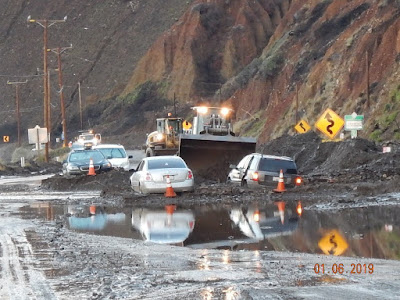Landslides in the United
States cause approximately $3.5 billion in damage, and kill between 25-50
people annually. The largest landslide in modern
U.S. history (in terms of volume) was most likely one that occurred in 2013
in Bingham
Canyon outside of Salt Lake City, Utah.
It had a slide mass of 55 million cubic meters (compared to an estimated 10
million cubic meters during the Oso event in 2014, see image below).
Landslides impact California’s terrain often. These are
generally related to precipitation patterns, in particular if there has been
previous months of drought conditions. In January 2019, Pacific storms brought
a lot of rainfall to the state. The heavy rain forced residents to evacuate
from wildfire-ravaged areas. The “high risk”
areas for mudslides are so because they are adjacent to steep slopes or are
located at the base of drainage areas. Recent examples are the ‘Woolsey’ and the ‘Hill’ fire burn areas,
which will be subject to high volume of mud and debris flow moving forward. The
photo below shows a 2019 example.


Hi professor Garcia this is Allan Perez. I enjoyed reading your post and was surprised to see how low the mortality rate from landslides was. I always thought that it was much higher given how many roads, and homes are located near areas with steep hill next to them. It was also interesting how one of the biggest landslides happened only 6 years ago.
ReplyDelete